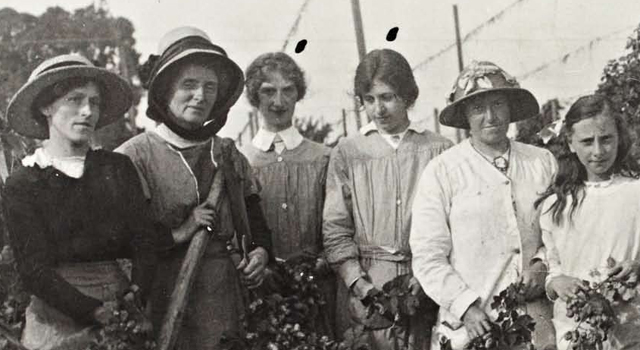Articles

No Comments
By Voices
On 13, Mar 2014 | No Comments | In Gender | By Voices
Gender and the Home Front
Professor Maggie Andrews, University of Worcester
Munitions workers and the Women’s Land Army are familiar images of the Home Front in the First World War when the number of women in paid employment increased by nearly 2 million. This alongside the introduction of votes for women in 1918 has led to suggestions that the conflict was a period of social change and women’s emancipation.
The majority of women remained in the home, or retained domestic roles and responsibilities alongside paid work. Many took on new roles and responsibilities in family businesses, farms and small holdings when husbands or sons left for war.
As the war progressed, with many men in the armed forces and submarine blockades creating difficulties in importing food there was growing concern over the food supply. Women had often been discouraged from working in the fields in the Edwardian period and most women who worked on the land did so as part of their husband’s employment on the family farm. In wartime however women were encouraged to undertake a variety of work in agriculture including helping to harvest the hops as shown in this picture.
![Agricultural workers [Image courtesy of Worcestershire Archive and Archaeology Service]](http://www.voicesofwarandpeace.org/wp-content/uploads/2014/03/worcester-archives.jpg) In 1917 the Women’s Land Army was formed by the Minister of Agriculture – Roland Prothero – who admitted that: ‘Physically the work is hard. It is monotonous. It is carried on out-of-doors in all conditions of weather’. Land girls were given training, a uniform and a wage of nearly a pound a week, with extra payments for particular skills such as ploughing or tractor driving. Although precise figures are hard to obtain there seems to have been between 11 and 20 thousand members of the Land Army and perhaps over a quarter of a million women working in agriculture during the war.
In 1917 the Women’s Land Army was formed by the Minister of Agriculture – Roland Prothero – who admitted that: ‘Physically the work is hard. It is monotonous. It is carried on out-of-doors in all conditions of weather’. Land girls were given training, a uniform and a wage of nearly a pound a week, with extra payments for particular skills such as ploughing or tractor driving. Although precise figures are hard to obtain there seems to have been between 11 and 20 thousand members of the Land Army and perhaps over a quarter of a million women working in agriculture during the war.
Many farmers however preferred to look to other sources of labour: lads too young to fight and men who were too old, members of the armed forces home on leave or recovering from injury and even German Prisoners of War. As the war ended many rural women withdrew from the workforce.



Submit a Comment